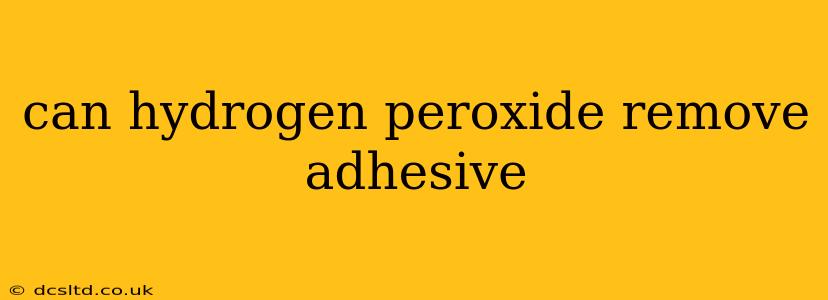Can Hydrogen Peroxide Remove Adhesive? A Comprehensive Guide
Hydrogen peroxide, a common household antiseptic, is surprisingly versatile. Many people wonder if its bubbling action can also tackle stubborn adhesive residue. The short answer is: sometimes, but it depends on several factors. While it's not a guaranteed solution for every adhesive, hydrogen peroxide can be effective in certain situations. This guide will explore its efficacy, limitations, and best practices.
What Types of Adhesives Can Hydrogen Peroxide Remove?
Hydrogen peroxide's effectiveness varies greatly depending on the type of adhesive. It's generally most effective on weaker, water-soluble adhesives. These include:
- Water-based glues: Common craft glues, school glues, and some wallpaper pastes are often susceptible to hydrogen peroxide's dissolving action.
- Certain sticker adhesives: Some sticker residues, particularly those from less aggressive stickers, may be softened and removed with hydrogen peroxide.
However, hydrogen peroxide is unlikely to remove:
- Strong adhesives: Super glue, epoxy, construction adhesive, and other strong, chemically-bonded adhesives are highly resistant to hydrogen peroxide.
- Oil-based adhesives: These adhesives require stronger solvents for removal.
- Acrylic adhesives: While some softening may occur, complete removal is often unlikely.
How to Use Hydrogen Peroxide to Remove Adhesive
If you decide to try hydrogen peroxide, follow these steps:
- Test in an inconspicuous area: Always test the peroxide on a small, hidden area first to ensure it doesn't damage the underlying surface. Some materials may be sensitive to hydrogen peroxide.
- Apply the peroxide: Pour a small amount of 3% hydrogen peroxide directly onto the adhesive residue.
- Let it sit: Allow the peroxide to soak into the adhesive for several minutes, allowing the bubbling action to work its magic. You might need to reapply it several times.
- Gently scrub: Use a soft cloth, sponge, or toothbrush to gently scrub the area. Avoid harsh scrubbing that could scratch the surface.
- Rinse and repeat: Rinse the area with clean water and repeat the process if necessary.
What are the Alternatives to Hydrogen Peroxide for Adhesive Removal?
If hydrogen peroxide isn't effective, several other methods can be employed, depending on the adhesive and the surface:
- Isopropyl alcohol: A good solvent for many adhesives.
- WD-40: Effective for some adhesives but can leave behind a residue, requiring further cleaning.
- Goo Gone: A commercial adhesive remover specifically designed for various adhesive types.
- Heat: A hairdryer or heat gun can soften some adhesives, making them easier to scrape off. However, always exercise caution to avoid damaging the surface.
- Mechanical removal: For stubborn adhesives, a plastic scraper or putty knife may be necessary, but use caution to avoid scratching the surface.
Does Hydrogen Peroxide Damage Surfaces?
While generally safe for many surfaces, hydrogen peroxide can bleach or discolor certain materials, especially fabrics and light-colored surfaces. Always test it in an inconspicuous area before applying it liberally. Furthermore, prolonged exposure can cause some materials to degrade.
Is Hydrogen Peroxide Safe for all Adhesives?
No, hydrogen peroxide is not safe or effective for all adhesives. Its effectiveness is limited to weaker, water-based adhesives. Always test a small area first and consider alternative methods for stronger adhesives.
How Long Should I Leave Hydrogen Peroxide on the Adhesive?
The necessary soaking time varies depending on the adhesive and its strength. Start with a few minutes and repeat as needed, monitoring for progress. Prolonged exposure may not necessarily improve results and could even damage the underlying surface.
By following these guidelines and understanding the limitations of hydrogen peroxide, you can determine if it's the right solution for your specific adhesive removal needs. Remember, safety and testing are crucial steps before tackling any adhesive removal project.
